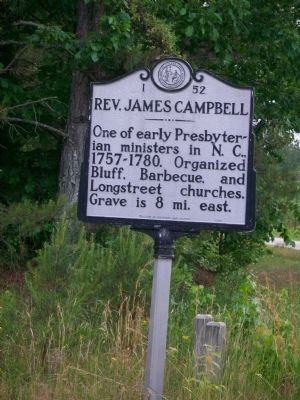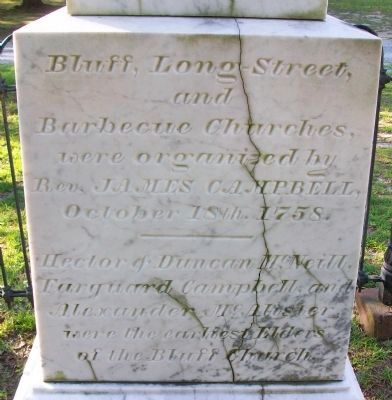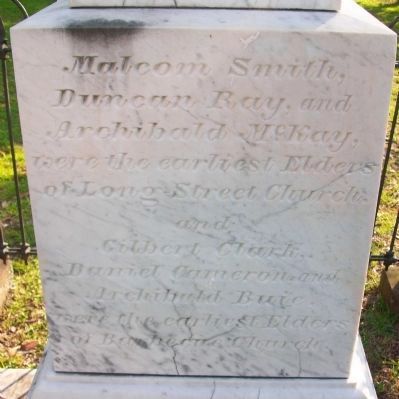Near Linden in Cumberland County, North Carolina — The American South (South Atlantic)
Rev. James Campbell
One of early Presbyterian ministers in N.C., 1757-1780. Organized Bluff, Barbecue, and Longstreet churches. Grave is 8 mi. east.
Erected 1980 by North Carolina Division of Archives and History. (Marker Number I-52.)
Topics and series. This historical marker is listed in these topic lists: Churches & Religion • Settlements & Settlers. In addition, it is included in the North Carolina Division of Archives and History series list.
Location. 35° 14.595′ N, 78° 49.081′ W. Marker is near Linden, North Carolina, in Cumberland County. Marker is at the intersection of Ramsey Street (U.S. 401) and East Reeves Bridge Road, on the right when traveling north on Ramsey Street. Touch for map. Marker is at or near this postal address: 9498 US 401, Linden NC 28356, United States of America. Touch for directions.
Other nearby markers. At least 8 other markers are within 8 miles of this marker, measured as the crow flies. Colonel Alexander McAllister (approx. 6.7 miles away); Old Bluff Church (approx. 6.7 miles away); a different marker also named Old Bluff Church (approx. 7.3 miles away); Federal Artillery (approx. 7.7 miles away); "Oak Grove" (approx. 7.8 miles away); 20th Corps (approx. 7.8 miles away); Battle of Averasboro (approx. 7.8 miles away); Taliaferro’s Division (approx. 7.8 miles away).
Regarding Rev. James Campbell. A Presbyterian minister, Campbell was born circa 1700 in Campbelltown, Scotland, and emigrated to Pennsylvania in 1730. Licensed by the Presbytery of New Castle in 1735, Campbell began questioning his personal salvation and ceased preaching in September 1739 shortly after moving to Philadelphia. Two months later, he witnessed a sermon by George Whitfield in New Brunswick, New Jersey. The experience completely reinvigorated Campbell’s devotion to his faith, and he returned shortly thereafter to his ministry.
In 1755, Hugh McAden visited Campbell on his way to North Carolina to ascertain the religious needs of Highland Scots in the region. On McAden’s return he convinced Campbell to move to North Carolina, and preach to the Scottish settlers in their own native Gaelic. Campbell did so in 1756 or 1757, preaching in communities located in the present counties of Cumberland, Harnett, Hoke and Lee, and Robeson, as well as “other destitute settlements” in South Carolina.
Campbell remained the only minister to preach in Gaelic until the arrival of John Bethune and John MacLeod in 1773. He organized
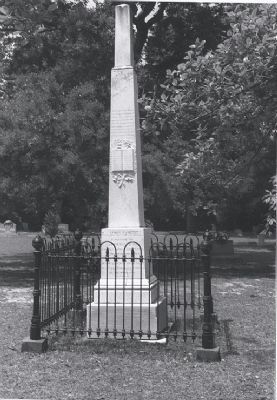
Courtesy of the Bluff Presbyterian Church
2. Monument to Rev. James Campbell
Campbell was the pioneer Pastor of the upper Cape Fear River valley. Born in Campbelton, Kintyre, Scotland about 1700 he came to America as a young man and to North Carolina in 1757. His actual grave is across the river. Source: The Bluff Presbyterian Church, Post Office Box 96, Wade, NC 28395-0096
During the American Revolution, Campbell, an outspoken Whig, ceased preaching in the Cape Fear River area because of Loyalist threats. He resumed his ministerial duties in Guilford County, only after having been rebuked by an elderly woman. Hearing the woman cursing, Campbell admonished her, to which she replied, “Is it any wonder the devil can make the mouth of a woman swear when he can stop the mouth of the minister.” In 1780, Campbell returned to the Cape Fear River valley, dying near his home that fall.
References:
William H. Foote, Sketches of North Carolina, Historical and Biographical (1846)
Malcom Fowler, They Passed This Way (1955)
William S. Powell, ed., Dictionary of North Carolina Biography, I, 314-315—sketch by James McKenzie
Also see . . . James Campbell. NCpedia website entry (Submitted on January 22, 2024, by Larry Gertner of New York, New York.)
Additional keywords. Carvers Creek
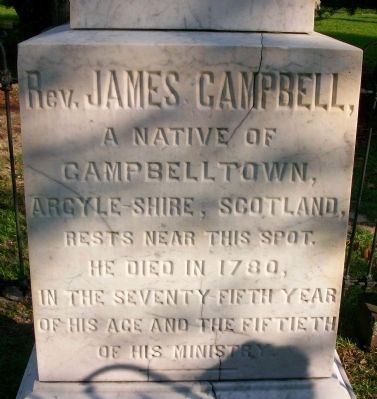
Photographed By Robert Cole, June 6, 2010
3. Rev. James Campbell Gravesite
"Rev. JAMES CAMPBELL, a native of Campbelltown, Argyle-shire, Scotland, rests near this spot. He died in 1780, in the seventy-fifth year of his age and the fiftieth of his ministry." Gravesite is located at Old Bluff Church Cemetery, near Wade, NC.
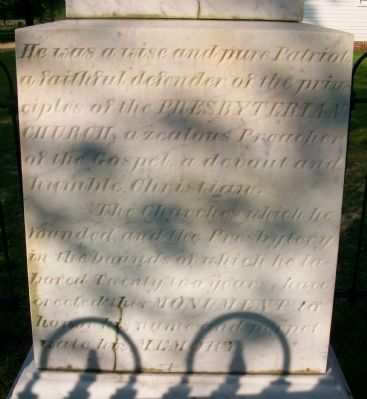
Photographed By Robert Cole, June 6, 2010
4. Rev. James Campbell Gravesite
"He was a wise and pure Patriot, a faithful defender of the principles of the PRESBYTERIAN CHURCH, a zealous Preacher of the Gospel, a devout and humble Christian. The Churches which he founded, and the Presbytery in the bounds of which he labored Twenty two years, have erected this MONUMENT to honor his name and perpetuate his MEMORY."
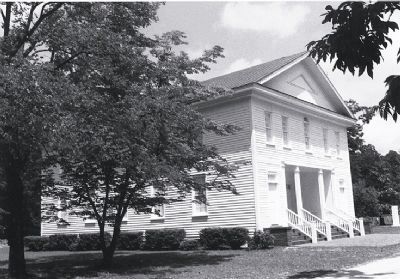
Courtesy of the Bluff Presbyterian Church
7. Old Bluff Presbyterian Church
This, the third structure to house the Bluff Presbyterian Congregation. It is simple in design but spacious with hand-hewn timbers and put together with hand-made nails and wooden pegs. Inside are two pot-bellied stoves and unique light fixtues. The balconies are on three sides accesible from outside entrances. It was restored in 2002 and is on the National Register of Historic Places. Source: The Bluff Presbyterian Church, Post Office Box 96, Wade, NC 28395-0096
Credits. This page was last revised on January 22, 2024. It was originally submitted on May 10, 2010, by Cleo Robertson of Fort Lauderdale, Florida. This page has been viewed 1,969 times since then and 75 times this year. Last updated on April 26, 2011, by Lee Hattabaugh of Capshaw, Alabama. Photos: 1, 2. submitted on May 10, 2010, by Cleo Robertson of Fort Lauderdale, Florida. 3, 4, 5, 6. submitted on June 6, 2010, by Cleo Robertson of Fort Lauderdale, Florida. 7. submitted on May 10, 2010, by Cleo Robertson of Fort Lauderdale, Florida. • Bill Pfingsten was the editor who published this page.
